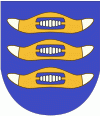Hyvinkää
 |
Highways (such as Tampere Highway (E12) and Hanko Highway) and rail connections make it one of the suburban commuter centers of Greater Helsinki. The city planning has had an emphasis on recreational facilities.
Some of the more well-known buildings in Hyvinkää are, among others, the Church (1961, Aarno Ruusuvuori) of Hyvinkää and the manor house of Kytäjä. The Finnish Railway Museum is located in Hyvinkää.
Hyvinkää is also home to Konecranes, which specializes in the manufacture and service of cranes, and KONE Elevators, the world's third-largest elevator company who manufacture, install and service elevators and escalators.
The workshop of Ruokangas Guitars, the leading Finnish electric guitar maker, was located at Wanha Villatehdas, Hyvinkää until 2011.
Hyvinkää is known among Scandinavian golf enthusiasts due to Kytäjä Golf, located in the village of Kytäjä located in the countryside of Hyvinkää. It offers two courses designed by Tom McBroom: South East Course opened in August 2003, and North West Course in August 2004.
In the 16th century there was a tavern in the area now known as Hyvinkäänkylä (literally "the village of Hyvinkää"), which lies approximately halfway between Helsinki and Hämeenlinna. It was mentioned the first time in 1495 as Höffinga. The first tax catalogues also marked the existence of some houses in the area around the same time. During the 16th century there was also a mine close to current-day Kytäjä village.
Hyvinkää village gradually grew in the latter half of the 19th century, though it was the construction of the railway network through Finland, beginning in 1861, that marked the starting point for the town's rapid growth. Hyvinkää, who still belonged to the Nurmijärvi parish at that time, resigned in 1917 as its own parishioner.
The construction of Finland's first stretch of railroad, the Helsinki–Hämeenlinna line, determined the location of the present city centre and the railway station of Hyvinkää is one of the few original stations still in use. From Hyvinkää the railway also branches off to the port of Hanko. The Hanko–Hyvinkää Railroad was the first private railroad in Finland, founded in 1862, and acquired by the Finnish State RR Co. in 1875. In the early 20th century, the station village in Hyvinkää was an intermediate stopping point for many emigrants leaving by ship from Hanko for a new life in North America.
The air quality of Hyvinkää was considered healthy due to dense pine forests, and in the 1880s a group of physicians from Helsinki opened a sanatorium for patients seeking rest and recuperation.
Map - Hyvinkää
Map
Country - Finland
 |
 |
| Flag of Finland | |
Finland was first inhabited around 9000 BC after the Last Glacial Period. The Stone Age introduced several different ceramic styles and cultures. The Bronze Age and Iron Age were characterized by contacts with other cultures in Fennoscandia and the Baltic region. From the late 13th century, Finland became a part of Sweden as a consequence of the Northern Crusades. In 1809, as a result of the Finnish War, Finland became part of the Russian Empire as the autonomous Grand Duchy of Finland, during which Finnish art flourished and the idea of independence began to take hold. In 1906, Finland became the first European state to grant universal suffrage, and the first in the world to give all adult citizens the right to run for public office. After the 1917 Russian Revolution, Finland declared independence from Russia. In 1918, the fledgling state was divided by the Finnish Civil War. During World War II, Finland fought the Soviet Union in the Winter War and the Continuation War, and Nazi Germany in the Lapland War. It subsequently lost parts of its territory, but maintained its independence.
Currency / Language
| ISO | Currency | Symbol | Significant figures |
|---|---|---|---|
| EUR | Euro | € | 2 |
| ISO | Language |
|---|---|
| FI | Finnish language |
| SV | Swedish language |















